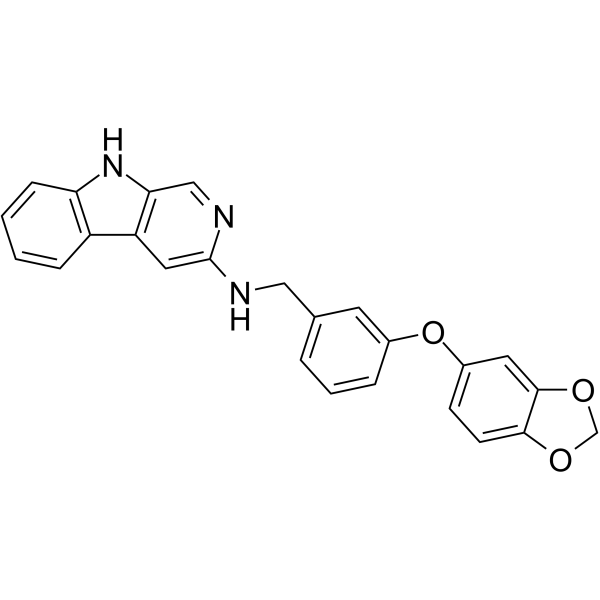| In Vitro |
αβ-Tubulin-IN-1 (compound 12 b) (0, 0.5, 1, 5, 10, 50 µM; 16 h) promotes αβ-tubulin degradation in a concentration-dependent manner in Hela and K562 (0-10 µM) cells[1]. αβ-Tubulin-IN-1 exhibits potent cytotoxic activity toward sensitive cells and resistant cells[1]. αβ-Tubulin-IN-1 (0-300 nM; 48 h) induces cell cycle arrest at G2/M and efficient apoptosis in A2780S and A2780T cells[1]. αβ-Tubulin-IN-1 (0, 1.25, 2.5, 5, 10 nM; 24, 48 h) inhibits tumor cell migration and Metastasis with the inhibition rate of 76.21% and 85.07% for 24 , 48 h in human umbilical vein endothelial cells (HUVEC)[1]. Cell Proliferation Assay[1] Cell Line: Hela, A2780S, MCF-7, Raji, H460 cells Concentration: 0-500 nM Incubation Time: 24 h Result: Showed anti-proliferative activity with IC50s of 5, 8, 9,13, 14 nM for Hela, A2780S, MCF-7, Raji, H460 cells, respectively. Western Blot Analysis[1] Cell Line: HeLa cells Concentration: 10 µM Incubation Time: 16 h Result: Remarkably promoted tubulin degradation by binding to the colchicine site, and the degradation process relied on the ubiquitin−proteasome pathway. Cell Viability Assay[1] Cell Line: A2780S, A2780T, A549, A549T, MCF7, MCF7/ADR cells Concentration: Incubation Time: 24 h Result: Exhibited potent cytotoxic activity with IC50s of 16.4, 13.1, 60.1, 63.8, 11.3, 13.5 nM for A2780S, A2780T, A549, A549T, MCF7, MCF7/ADR cells, respectively. Cell Cycle Analysis[1] Cell Line: A2780S (PTX-sensitive), A2780T ( PTX-resistant) cells Concentration: 0, 3, 10, 30, 100, 300 nM Incubation Time: 48 h Result: Induced cell cycle arrest at G2/M phase with the the percentages of A2780S and A2780T cells were 55.10%, 72.18% at 100 nM, and 79.54%, 72.89% at 300 nM. Apoptosis Analysis[1] Cell Line: A2780S, A2780T cells Concentration: 0, 3, 10, 30, 100, 300 nM Incubation Time: 48 h Result: Induced cell apoptosis with the total numbers of late apoptotic cells were 3.7%, 25.2%, 30.6% at 30,100, and 300 nM, and 5.2% % late apoptotic cells in control.
|
| In Vivo |
αβ-Tubulin-IN-1 (5 mg/kg; i.v., p.o.) shows intravenous and oral administration approaches are available in vivo[1]. αβ-Tubulin-IN-1 (10, 20, 40 mg/kg; i.v.; 3 times a week for 2-4 weeks) shows significant antitumor efficacy in a dose dependent manner[1]. Pharmacokinetic Parameters of αβ-Tubulin-IN-1 in rats[1]. route i.v. p.o. dose (mg/kg) 5 5 T1/2 (h) 3.57±1.10 4.42±1.90 CL (L/h/kg) 1.52±0.39 5.06±1.70 Vss (L/kg) 8.08±4.19 35.26±25.76 AUC0-∞ (µg/mL·h) 3448.81±782.66 1058.74±285.62 Cmax (µg/L) 2601.47±444.20 189.29±119.02 F (%) 30.70Rats, 5 mg/kg for i.v., 5 mg/kg for p.o.[1]. Animal Model: Rats[1] Dosage: 5 mg/kg Administration: I.v. or p.o. Result: Showed oral bioavailability (F=30.70%) with the T1/2 values for intravenous and oral administration approaches are 3.57 h and 4.42 h, respectively. Animal Model: 5-6weeks female Balb/C and athymic nude mice (A2780S and A2780T Xenograft) Models[1] Dosage: 10, 20, 40 mg/kg for i.v., 40 mg/kg for p.o. Administration: I.v.; 3 times a week for 2-4 weeks Result: Showed significant antitumor efficacy with tumor growth inhibition (TGI) of 66.06%, 71.47% and 92.41% at 10, 20 and 40 mg/kg in A2780S xenograft nude mice model, and 26.94%, 37.2%, 75.73% at 10, 20 and 40 mg/kg in PTX-resistant A2780T xenograft model for i.v. injection, did not show an acceptable antitumor efficacy with 34.93% of TGI at the 40 mg/kg for p.o..
|
